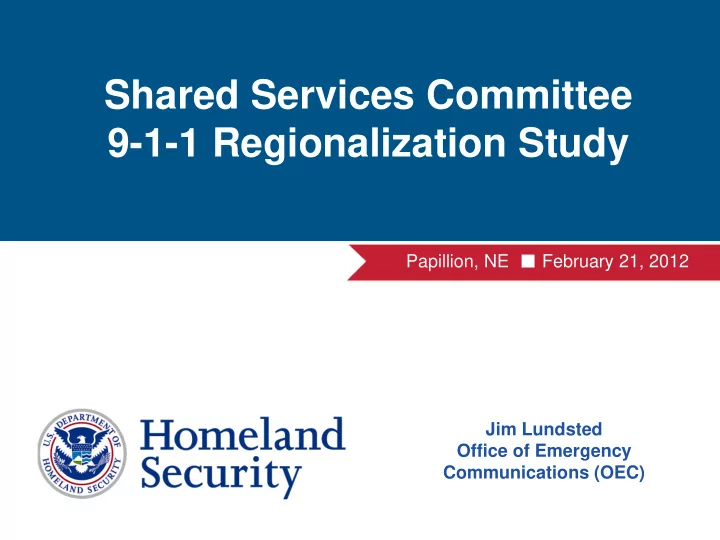

National Council of Statewide Shared Services Committee Interoperability 9-1-1 Regionalization Study Coordinators Meeting Papillion, NE ■ February 21, 2012 Atlanta, GA ■ December 7-8, 2011 Jim Lundsted Office of Emergency Communications (OEC)
Mission The mission of OEC is to unify and lead the nationwide effort to improve emergency communications capabilities across all levels of government
Interoperability Continuum
National Emergency Communications Plan Vision – Emergency responders can communicate as needed, on demand, as authorized; at all levels of government; and across all disciplines Released July 2008 Developed in coordination with 150+ representatives from all major public safety organizations and private sector Addresses operability, interoperability, continuity First National Strategic Plan 3 Performance-based Goals 7 Objectives that set priorities 92 Milestones to track progress Implementation Build capability/capacity (governance, exercises, SOP, usage) National assessments Target resources (funding, technical assistance, training)
Regional Planning Guidance OEC guidance documents share best practices and strategies proven successful in achieving common goals for interoperable communications Recognizing a future for public safety communications that will be more robust, more complex, and more expensive to build and maintain, many jurisdictions are studying how partnerships, including shared systems strategies may be advantageous Some good examples of shared systems include Kansas City’s (Mid -America Regional Council) regional area multi-band regional interoperable radio system (RAMBIS) and the OPPD shared microwave network used by Douglas, Sarpy, Washington and Pottawatomie (IA) counties
Concept of Shared Services Key understandings must exist among stakeholders: o Costs savings are NOT typically realized at the beginning o Savings are usually achieved, over time, in lower costs per call, economies of scale in administrative support, training, and equipment operations, and maintenance (O & M), and hardware/software upgrade costs o Implementing major changes, such as Next Generation 9-1-1, EMD or public-safety broadband is more efficient and cost effective in a shared system than in multiple, smaller emergency communications centers o Larger centers allow employee tasks to be focused: call takers vs. dispatch, as opposed to having a center’s staff assigned to multiple duties (such as call taker and dispatch, training leader, technical support or handling additional administrative duties) o The over-arching goal in successful implementations of shared services is to enhance services, not solely to achieve financial savings.
Next Generation 9-1-1
Future Preparedness Grants
Future Preparedness Grants • As government at all levels transitions from years of building new capabilities under Homeland Security grant programs to the new preparedness grants (Presidential Policy Directive-8) as the basis for future funding priorities, the whole community concept will increasingly set priorities for grants. Not only must we maintain and sustain capabilities we have established, we’ll also need to work to eliminate duplications to continue to maintain what we now have. An example: many communities cannot afford a fully-equipped HazMat team. Could the capabilities of these teams be shared, with initial response capability maintained in your community, and rely on a regional asset for larger incidents?
Wireless Broadband Planning Planning for Wireless Broadband – Continue partnerships with Federal agencies and public safety – Determine technical requirements – Focus on all lanes of the Interoperability Continuum as new technology develops
Public Safety Communications Evolution
Contact Information OEC oec@dhs.gov WEB www.dhs.gov, search keyword: OEC Guidance Documents www.dhs.gov, search keyword: OEC Publications Jim Lundsted (573) 298-0484 (202) 630-1177 (cell) james.lundsted@dhs.gov
Office of Emergency Communications
Recommend
More recommend